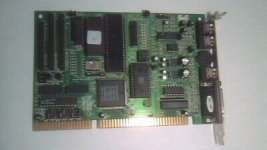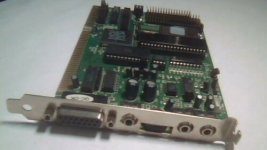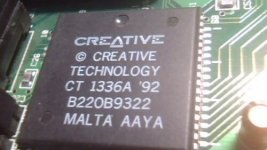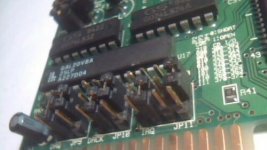Haunter_1
Member
Hello Everyone,
I recently purchased a seemingly rare Sound Blaster clone and would like to know if anyone has any information on it, or if there are any particular SB driver versions and jumper positions that would allow me to test it for functionality on my IBM XT. The attached pictures are small and were provided by the seller, but they do match the card I recieved.




It appears to be an 8-bit card, with the 16-bit ISA bus being used only for the CD-ROM function. It has a CT 1336a chip, and has an 8031 cpu. The seller referred to it as SB Pro 2, however when I attempted to install SB drivers the card was detected as a Sound Blaster 2.0.
I don't plan to use it for games, but it would be nice to test it on my XT. It has a lot of jumpers which I believe to be a good thing, however I am not sure whether or not the scheme matches any of the SB cards. I am still very new to pre Pentium/windows machines and any help would be greatly appreciated.
My IBM specs are as follows:
IBM 5155 XT
640k Memory
CGA Graphics (7.5" MC only + composite monitor)
Blue Lava Sys XTIDE-CF
64mb CF HDD
Dual 5.25" 360kb FDs
PC-Dos 4.01
NEC P2 Parallel printer
I recently purchased a seemingly rare Sound Blaster clone and would like to know if anyone has any information on it, or if there are any particular SB driver versions and jumper positions that would allow me to test it for functionality on my IBM XT. The attached pictures are small and were provided by the seller, but they do match the card I recieved.




It appears to be an 8-bit card, with the 16-bit ISA bus being used only for the CD-ROM function. It has a CT 1336a chip, and has an 8031 cpu. The seller referred to it as SB Pro 2, however when I attempted to install SB drivers the card was detected as a Sound Blaster 2.0.
I don't plan to use it for games, but it would be nice to test it on my XT. It has a lot of jumpers which I believe to be a good thing, however I am not sure whether or not the scheme matches any of the SB cards. I am still very new to pre Pentium/windows machines and any help would be greatly appreciated.
My IBM specs are as follows:
IBM 5155 XT
640k Memory
CGA Graphics (7.5" MC only + composite monitor)
Blue Lava Sys XTIDE-CF
64mb CF HDD
Dual 5.25" 360kb FDs
PC-Dos 4.01
NEC P2 Parallel printer
